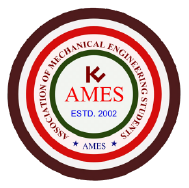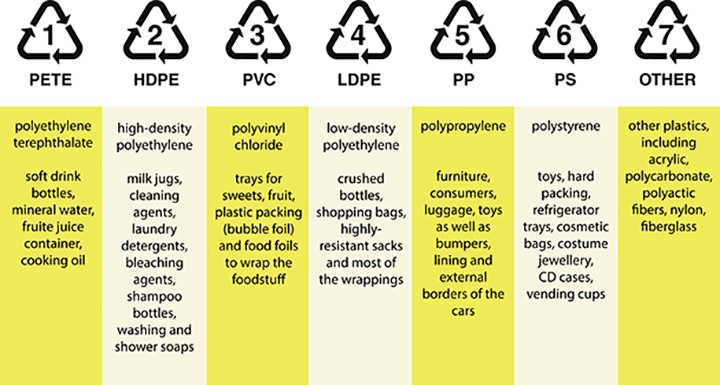The well-recognized “chasing arrows” symbol we see on plastic containers and products does not mean the product is recyclable. The little number inside the triangle tells the real story.
Within each chasing arrows triangle, there is a number which ranges from one to seven. The purpose of the number is to identify the type of plastic used for the product, and not all plastics are recyclable or even reusable. There are numerous plastic-based products that cannot break down and cannot be recycled.
The picture below shows the plastic by their assigned numbers as a brief description about those:
The various aspects of the above classified plastics are discussed below:
#1 – PET (Polyethylene Terephthalate)
PET is one of the most commonly used plastics in consumer products, and is found in most water and pop bottles, and some packaging. It is intended for single use applications; repeated use increases the risk of leaching and bacterial growth. PET plastic is difficult to decontaminate, and proper cleaning requires harmful chemicals. Polyethylene terephthalates may leach carcinogens.
PET plastic is recyclable. The plastic is crushed and then shredded into small flakes which are then reprocessed to make new PET bottles, or spun into polyester fiber. This recycled fiber is used to make textiles such as fleece garments, carpets, stuffing for pillows and life jackets, and similar products.
Products made of #1 (PET) plastic should be recycled but not reused.
#2 – HDPE (High-Density Polyethylene)
HDPE plastic is the stiff plastic used to make milk jugs, detergent and oil bottles, toys, and some plastic bags. HDPE is the most commonly recycled plastic and is considered one of the safest forms of plastic. It is a relatively simple and cost-effective process to recycle HDPE plastic for secondary use.
HDPE plastic is very hard-wearing and does not break down under exposure to sunlight or extremes of heating or freezing. For this reason, HDPE is used to make picnic tables, plastic lumber, waste bins, park benches, bed liners for trucks and other products which require durability and weather-resistance.
Products made of HDPE are reusable and recyclable.
#3 – PVC (Polyvinyl Chloride)
PVC is a soft, flexible plastic used to make clear plastic food wrapping, cooking oil bottles, teething rings, children’s and pets’ toys. It is commonly used as the sheathing material for computer cables, and to make plastic pipes and parts for plumbing. Because PVC is relatively impervious to sunlight and weather, it is used to make window frames and garden hoses too.
PVC is dubbed the “poison plastic” because it contains numerous toxins which it can leach throughout its entire life cycle. Almost all products using PVC require virgin material for their construction; less than 1% of PVC material is recycled.
Products made using PVC plastic are not recyclable. While some PVC products can be repurposed. PVC products should not be reused for applications with food or for children’s use.
#4 – LDPE (Low-Density Polyethylene)
LDPE is often found in squeezable bottles, and the type of plastic bags used to package bread. The plastic grocery bags used in most stores today are made using LDPE plastic. Some clothing and furniture also use this type of plastic.
LDPE is considered less toxic than other plastics, and relatively safe for use. Products made using recycled LDPE are not as hard or rigid as those made using recycled HDPE plastic.
Products made using LDPE plastic are reusable, but not always recyclable.
#5 – PP (Polypropylene)
Polypropylene plastic is tough and lightweight, and has excellent heat-resistance qualities. It serves as a barrier against moisture, grease and chemicals. PP is also commonly used for disposable diapers, pails, plastic bottle tops, margarine and yogurt containers, potato chip bags, straws, packing tape and ropes.
PP is considered safe for reuse and are recyclable too.
#6 – PS (Polystyrene)
Polystyrene is an inexpensive, lightweight and easily-formed plastic with a wide variety of uses. It is most often used to make disposable Styrofoam drinking cups, egg cartons, plastic picnic cutlery and foam packaging.
Because polystyrene is structurally weak and ultra-lightweight, it breaks up easily and is dispersed readily throughout the natural environment.
Polystyrene may leach styrene, a possible human carcinogen, into food products (especially when heated in a microwave). Chemicals present in polystyrene have been linked with human health and reproductive system dysfunction.
The products made from PS plastics are safe to reuse but are not recyclable.
#7 – Other (BPA, Polycarbonate and LEXAN)
The #7 category was designed as a catch-all for polycarbonate (PC) and “other” plastics, so reuse and recycling protocols are not standardized within this category. Of primary concern with #7 plastics, however, is the potential for chemical leaching into food or drink products packaged in polycarbonate containers made using BPA (Bisphenol A). BPA is a xeno-estrogen, a known endocrine disruptor.
Number 7 plastics are used to make baby bottles, sippy cups, water cooler bottles and car parts. BPA is found in polycarbonate plastic food containers often marked on the bottom with the letters “PC” by the recycling label #7. Some polycarbonate water bottles are marketed as ‘non-leaching’ for minimizing plastic taste or odor, however there is still a possibility that trace amounts of BPA will migrate from these containers, particularly if used to heat liquids.
A new generation of compostable plastics, made from bio-based polymers like corn starch, is being developed to replace polycarbonates. These are also included in category #7, which can be confusing to the consumer. These compostable plastics have the initials “PLA” on the bottom near the recycling symbol. Some may also say “Compostable.”
#7 plastics are not for reuse, unless they have the PLA compostable coding. When possible, it is best to avoid #7 plastics, especially for children’s food. Plastics with the recycling labels #1, #2 and #4 on the bottom are safer choices and do not contain BPA. PLA coded plastics should be thrown in the compost and not the recycle bin since PLA compostable plastics are not recyclable.
- AMES BULLETIN
Adapted from: Plastic by numbers, Greg Seaman.
Published originally on: Eartheasy

